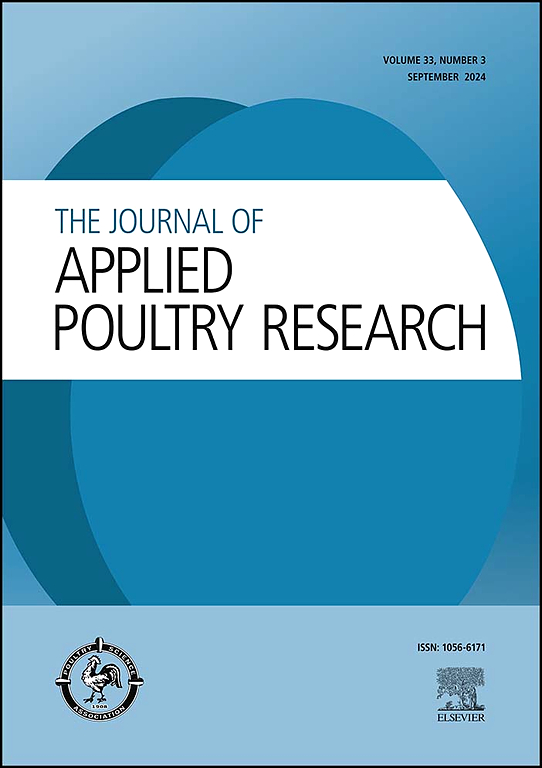Current approaches to the ongoing challenges of mycotoxins in poultry diets: Understanding and combating mycotoxins for sustainable poultry production
IF 2
3区 农林科学
Q2 AGRICULTURE, DAIRY & ANIMAL SCIENCE
引用次数: 0
Abstract
The poultry industry continues to expand, addressing mycotoxin contamination in feed becomes compulsory. Mycotoxins pose a significant threat to poultry health as they contaminate both pre- and post-harvest crops. The co-occurrence of multiple mycotoxins decreases individual tolerance levels, even at subclinical levels, which can be considered to increase the pathology of individual mycotoxins in poultry. Mycotoxin interactions within the animal system are mainly additive in nature. The ultimate goal of achieving sustainable poultry production is to reduce the mycotoxin load in feed and its impact on downstream poultry food safety. This poultry science association annual conference symposium paper focuses on understanding the complex interactions among mycotoxins, notably fumonisins, deoxynivalenol, zearalenone, and aflatoxin, and their cumulative effects on poultry health. The co-occurrence of multiple mycotoxins in poultry feed ingredients exacerbates their effects on each other and impacts chicken production performance and health, necessitating a reevaluation of current mitigation strategies. Key discussions included the cascading effects of feed safety and mycotoxin interactions impacting poultry health, including intestinal epithelial barrier function, immunosuppression, and gut microbiome composition, leading to necrotic enteritis and foodborne pathogen contamination. Challenges faced by the poultry industry, such as the limited efficacy of traditional mycotoxin binders against fumonisins and deoxynivalenol, were discussed. The urgent need for real-time biomarkers to detect subclinical mycotoxicity was emphasized. Additionally, potential intervention strategies, including probiotics, mycotoxin deactivating enzymes, and mycotoxin binders, were discussed to mitigate mycotoxin impacts in poultry.
当前应对家禽日粮中真菌毒素挑战的方法:了解和对抗真菌毒素,促进家禽可持续生产
家禽业继续扩大,解决饲料中的霉菌毒素污染成为必须解决的问题。真菌毒素对家禽健康构成重大威胁,因为它们会污染收获前和收获后的作物。多种真菌毒素的共存降低了个体的耐受性水平,甚至在亚临床水平,这可以被认为增加了家禽个体真菌毒素的病理。真菌毒素在动物系统内的相互作用本质上主要是加性的。实现可持续家禽生产的最终目标是减少饲料中的霉菌毒素负荷及其对下游家禽食品安全的影响。这篇家禽科学协会年度会议研讨会论文的重点是了解真菌毒素之间复杂的相互作用,特别是伏马菌素、脱氧雪腐镰刀菌醇、玉米赤霉烯酮和黄曲霉毒素,以及它们对家禽健康的累积影响。家禽饲料成分中多种真菌毒素的共存加剧了它们之间的相互影响,并影响了鸡的生产性能和健康,因此有必要重新评估目前的缓解策略。重点讨论包括饲料安全和真菌毒素相互作用对家禽健康的级联效应,包括肠上皮屏障功能、免疫抑制和肠道微生物组组成,导致坏死性肠炎和食源性病原体污染。讨论了家禽业面临的挑战,例如传统霉菌毒素结合剂对伏马毒素和脱氧雪腐镰刀菌醇的有限功效。迫切需要实时生物标志物来检测亚临床真菌毒性。此外,还讨论了潜在的干预策略,包括益生菌、霉菌毒素灭活酶和霉菌毒素结合剂,以减轻霉菌毒素对家禽的影响。
本文章由计算机程序翻译,如有差异,请以英文原文为准。
求助全文
约1分钟内获得全文
求助全文
来源期刊

Journal of Applied Poultry Research
农林科学-奶制品与动物科学
CiteScore
4.10
自引率
10.50%
发文量
80
审稿时长
104 days
期刊介绍:
The Journal of Applied Poultry Research (JAPR) publishes original research reports, field reports, and reviews on breeding, hatching, health and disease, layer management, meat bird processing and products, meat bird management, microbiology, food safety, nutrition, environment, sanitation, welfare, and economics. As of January 2020, JAPR will become an Open Access journal with no subscription charges, meaning authors who publish here can make their research immediately, permanently, and freely accessible worldwide while retaining copyright to their work. Papers submitted for publication after October 1, 2019 will be published as Open Access papers.
The readers of JAPR are in education, extension, industry, and government, including research, teaching, administration, veterinary medicine, management, production, quality assurance, product development, and technical services. Nutritionists, breeder flock supervisors, production managers, microbiologists, laboratory personnel, food safety and sanitation managers, poultry processing managers, feed manufacturers, and egg producers use JAPR to keep up with current applied poultry research.
 求助内容:
求助内容: 应助结果提醒方式:
应助结果提醒方式:


